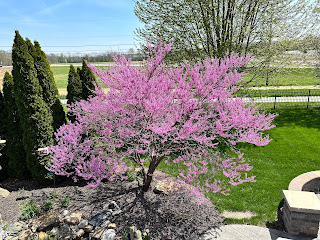Redbud - the tree you can snack on!
Redbud trees are in bloom and looking gorgeous on the edges of woodland areas and in my own yard. This native tree has been a food source for centuries. On a sunny day, it's not unusual for me to pull a few blossoms off of my backyard tree and snack on them right on the spot. They taste a bit like snap peas, and are a great source of Vitamin C! You can eat Redbuds a number of ways. The flowers are the most commonly eaten part of the tree, and they can be eaten raw, cooked, or pickled. The buds can be pickled or used as a caper substitute. The young pods can be fried or added to stir-fries.
- Pick the flowers when they are fully open.
- Rinse the flowers in cold water to remove any dirt or insects.
- Use the flowers immediately or store them in the refrigerator for up to 2 days.
Here are some recipes that use redbud flowers:
- Redbud Flower Salad
- Redbud Flower Pancakes
- Redbud Flower Jelly
- Redbud Flower Lemonade
I have made the Redbud jelly in the past, and I personally like to use the Ball jelly jars (link to Amazon order below). One tip - don't skimp on the sugar. Your jelly won't set if you don't use enough sugar! Redbud jelly would pair well with some crackers or melba toast.
Please note that the redbud tree is a member of the pea family, and some people are allergic to peas. If you are allergic to peas, you should not eat redbud flowers.
- Only eat the flowers, flower buds, and young pods of the redbud tree. The bark and leaves are not as commonly consumed and may not be safe to eat.
- Pick the flowers and flower buds when they are fresh and young. The flowers will start to wilt and the flower buds will become hard as they age.
- The pods can be eaten raw or cooked. If you are cooking the pods, be sure to remove the seeds before eating.
- Redbud tree flowers are a good source of vitamin C. They also have a mild, sweet flavor.
- Redbud tree flower buds have a slightly sour taste. They can be pickled or used as a caper substitute.
- Redbud tree pods are a good source of fiber. They have a mild, nutty flavor.
It is important to note that redbud tree is a member of the pea family, which means that it contains alkaloids. Alkaloids are naturally occurring chemicals that can be toxic in high doses. However, the levels of alkaloids in redbud tree are not considered to be harmful when consumed in moderation.
As with any wild edible, it is important to identify the plant correctly before consuming it. If you are not sure whether or not a plant is safe to eat, it is best to err on the side of caution and avoid it. I have both of the books below, and they have been a great help to me in identifying wild edibles and what to do with them after I have picked them!
(As an Amazon Associate, I earn from qualifying purchases. I get commissions for purchases made through links in this post.)
General information on harvesting and using native plants
When foraging for edibles, it is important to be sure that you are identifying the plants correctly. Some plants can be poisonous, so it is always best to err on the side of caution. If you are unsure about whether a plant is edible, it is best to leave it alone.
Collect from familiar areas, where pesticides are not used. Do not collect plants from roadsides. You do not know what, if any, chemicals have been used - not to mention runoff chemicals from the road.
Many edibles have medicinal properties as well. The properties could interact poorly with certain medications or health conditions. Consult with your healthcare professional.
This blog is for informational purposes only and does not constitute medical advice. The information on this blog is not intended to diagnose, treat, cure, or prevent any disease. Always consult with a doctor before making any changes to your diet or lifestyle.
The author of this blog is not responsible for any damages or losses that may occur as a result of following the information on this blog. Do your due diligence when researching edible and medicinal plants.




Comments
Post a Comment